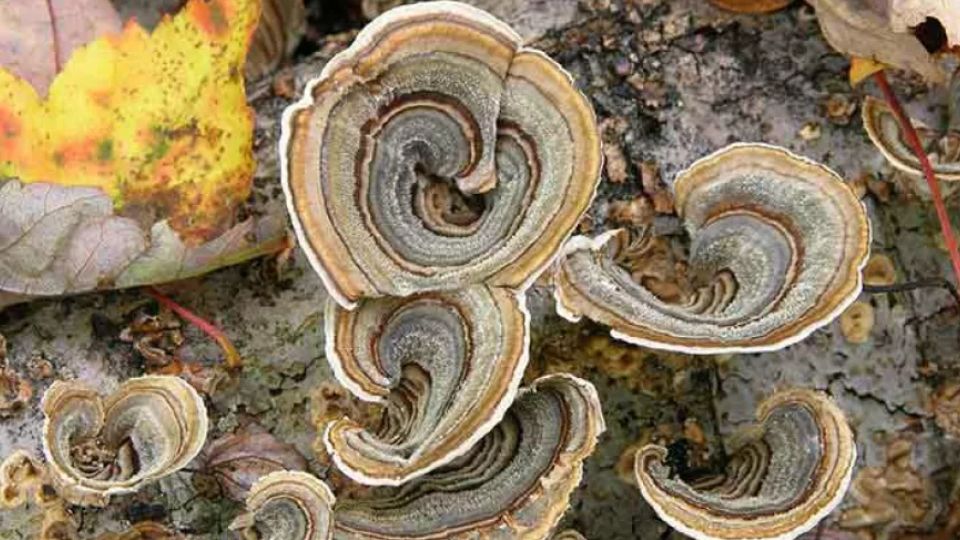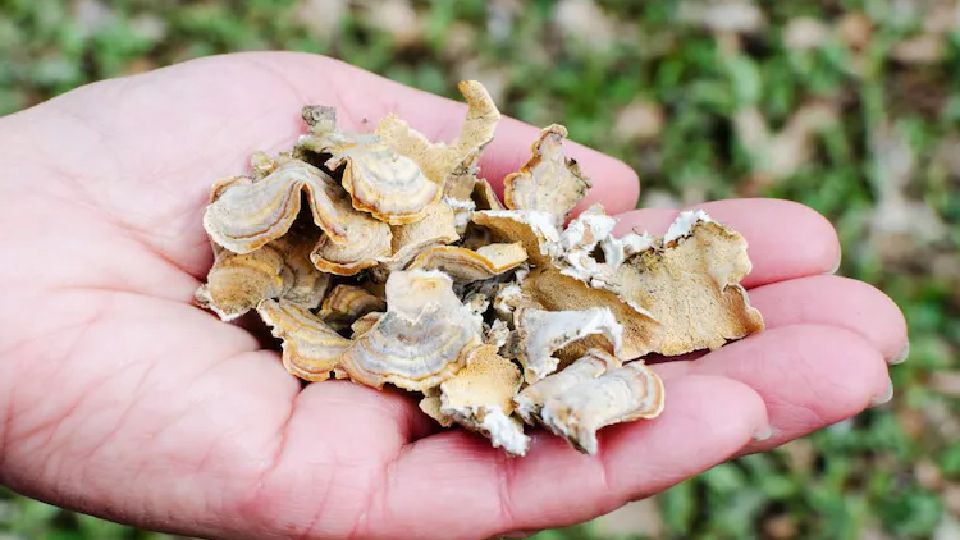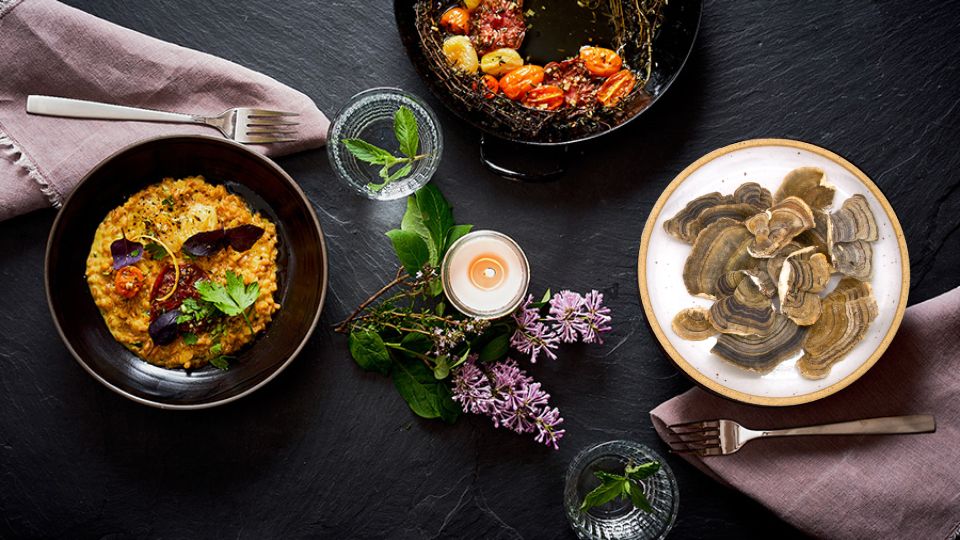How to Cook Turkey Tail Mushrooms: Healthy & Tasty
If you’ve ever foraged for wild mushrooms or have a deep interest in mycology, you might have come across the intriguing and health-beneficial turkey tail mushrooms. These unique fungi have gained popularity in recent years due to their potential health benefits, especially in supporting the immune system and as an adjunct to cancer treatments.
In this article, we will explore the wonders of turkey tail mushrooms and provide you with everything you need to know to prepare and cook these delightful fungi, from their identification and harvesting techniques to their health benefits, and most importantly, how to cook and incorporate them into delicious recipes.
In this article:
What are Turkey Tail Mushrooms?
Turkey tail mushrooms, scientifically known as Trametes versicolor, are one of the most common fungi found in the wild. They are commonly found in North America, Europe, and Asia, and get their name from their distinctive shape resembling the tail feathers of a turkey. They have a tough, fibrous texture and a mild, earthy flavor that pairs well with other ingredients.
Identify and Harvesting Turkey Tail Mushrooms

Before you embark on a culinary adventure with turkey tail mushrooms, it’s essential to know how to properly identify and harvest them. These mushrooms often grow in dense clusters on decaying logs or fallen trees in woodland areas. When foraging for them, look for thin, flexible mushroom caps with various colors, ranging from shades of brown, beige, and even green.
To harvest turkey tail mushrooms, use a sharp knife or scissors to cut the mushrooms at the base of their stalks. Always ensure that you leave some mushrooms behind to allow for future growth and the ecological balance of the environment.
Read More: Turkey Tail Mushrooms Identification
Turkey Tail Mushrooms Health Benefits
These mushrooms offer not only a delicious taste but also a plethora of health benefits, they offer valuable support to your body’s natural immune response due to their rich nutrient content. They contain essential compounds like beta-glucan polysaccharides, Polysaccharide-K (PSK), Polysaccharide peptide (PSP), Glutathione, Polyphenols, Ergothioneine, and Prebiotics[1].
These naturally occurring compounds, including beta-glucans and polysaccharide-K, act as immunomodulators, helping to boost your immune system’s effectiveness[2]. Alongside that, other nutrients present in turkey tail mushrooms contribute to maintaining a healthy digestive system[3].
Research suggests that turkey tail mushrooms may be particularly helpful in breast cancer and colon cancer, thanks to their anti-cancer properties. Moreover, these fungi have shown promise in lowering blood sugar levels[4].
To fully enjoy these health benefits, consider incorporating the recommended dosage of turkey tail mushrooms into your daily routine. By doing so, you can support your immune system and enhance your overall health.
Turkey Tail Mushrooms Nutrition Facts
Here’s a table displaying the approximate nutritional values of turkey tail mushrooms per 100g:
| Nutrient | Amount per 100g |
|---|---|
| Calories | 35 kcal |
| Carbohydrates | 7.2 g |
| Protein | 2.5 g |
| Fat | 0.3 g |
| Fiber | 3.5 g |
| Vitamin C | 2.4 mg |
| Iron | 0.68 mg |
| Potassium | 226 mg |
Please keep in mind that the nutritional content may slightly vary depending on the specific turkey tail mushrooms and their preparation. Always refer to reliable sources for accurate and up-to-date information.
How to Properly Clean and Prepare Turkey Tail Mushrooms
Once you’ve harvested your fresh turkey tail mushrooms, it’s essential to clean and prepare them properly for cooking. Start by brushing off any dirt or debris gently. Avoid using water to clean them, as mushrooms are like sponges and can absorb moisture, which affects their texture and flavor.
To utilize these mushrooms in a powdered form, you can dry turkey tail mushrooms and then grind them. To do this, slice the mushrooms into small pieces and place them in a well-ventilated area or a dehydrator until they are completely dry. Then, grind them into a fine powder using a blender or a coffee grinder. This mushroom powder can be added to various recipes, providing a boost of flavor and potential health benefits.
How to Cook Turkey Tail Mushrooms

Turkey tail mushrooms are incredibly versatile in the kitchen and can be prepared using various cooking methods. Moreover, feel free to substitute them for other mushrooms in your favorite dishes for a delightful twist.
Here are some popular techniques to bring out the best flavors from these delightful fungi:
1. Sautéing
Sautéing turkey tail mushrooms in a pan with a bit of olive oil or butter can enhance their earthy flavor and bring out their natural umami taste. You can add sautéed turkey tail to pasta dishes, risottos, or even as a topping for grilled meats.
2. Roasting
Roasting turkey tail mushrooms in the oven allows them to develop a rich and concentrated flavor. Toss them with some herbs and olive oil before roasting, and they’ll be the perfect addition to any dish or salad.
3. Risotto
Infuse your risottos with the delightful flavors of turkey tail mushrooms. As you cook the rice in broth, add in sautéed turkey tail mushrooms for a satisfying and aromatic meal.
4. Tea
Turkey tail tea is a traditional way to enjoy the health benefits of these fungi. Simmer dried turkey tail mushrooms in hot water for a nourishing and soothing beverage.
5. Broth
Create a delicious savory soup broth using turkey tail mushrooms. Add either fresh mushrooms or mushroom powder to water and combine them with your favorite vegetables, herbs, and spices. This will enhance the broth’s natural earthy flavor, making it even more satisfying.
If you prefer a more convenient option, consider trying a blended mushroom broth mix. Simply mix the dry packet into hot water, and you’ll have a flavorful broth ready to enjoy on its own or use in various recipes.
6. Coffee
For those who enjoy pungent or bitter coffee, adding turkey tail mushroom powder might be a suitable option. It offers a convenient way to incorporate the recommended dosage into your daily routine, supporting your body’s natural immune functions.
Keep in mind that turkey tail mushroom powder might not blend as smoothly into hot coffee compared to other mushroom powders like lion’s mane. Having a frother on hand can be helpful to achieve a smoother texture and better overall taste.
Read More: Turkey Tail Mushroom Recipes
How to Incorporate Turkey Tail Mushroom Powder into Recipes
Incorporate turkey tail mushrooms into your daily diet easily with certified, organic mushroom supplements, powders, drink mixes, gummies, and broths. Choose products are made from carefully grown functional mushrooms that undergo a thorough process of dehydration and milling. And each single-species turkey tail mushroom product is meticulously tested for quality, ensuring you get the best. Plus, every serving contains 2,000 mg or more of mushroom powder, which is an effective amount for supporting your everyday health. Embrace the goodness of turkey tail mushrooms in your diet and experience their benefits with these high-quality options.
One of the best Turkey tail products you can try: Real Mushrooms Turkey tail Product.
How to Cook Turkey Tail Mushrooms: Tips and Tricks
To ensure you make the most of these fantastic fungi, here are some helpful tips and tricks:
- Selecting Turkey Tail Mushrooms: Choose fresh turkey tail mushrooms with vibrant colors and a firm texture.
- Pairing with Other Ingredients: Complement turkey tail mushrooms with ingredients that enhance their earthy flavor, such as garlic, thyme, and other mushrooms.
- Storing Turkey Tail Mushrooms: Keep fresh turkey tail mushrooms in a paper bag in the refrigerator for up to a week. Alternatively, you can dry them for long-term storage and later use.
FAQs
How Do You Eat Fresh Turkey Tail Mushrooms?
To eat fresh Turkey Tail mushrooms, clean them by brushing off dirt and debris. Slice them thinly and cook in various dishes like soups, stir-fries, or sautés. They add an earthy flavor and can be a healthy addition to your meals. Ensure proper cooking as consuming them raw isn’t recommended.
Can You Cook and Eat Turkey Tail Mushrooms?
Yes, you can cook and eat turkey tail mushrooms. They’re safe when properly prepared. Slice and sauté them for a tasty addition to dishes, or make tea from dried turkey tail for its potential health benefits. Always ensure you’re confident in identifying them or consult an expert before foraging wild mushrooms.
How Do You Clean Turkey Tail Mushrooms?
Cleaning turkey tail mushrooms is simple. Gently brush off dirt with a soft brush or damp paper towel. Avoid soaking them, as they absorb water. Trim any tough or dirty parts. They’re now ready for cooking in your favorite recipes.
Can you eat all turkey tail mushrooms?
Turkey Tail mushrooms are safe to eat or take as a supplement. Start with small doses to avoid adverse reactions. Avoid them during pregnancy or while breastfeeding.
Conclusion
In conclusion, turkey tail mushrooms are not only a delicious addition to various dishes but also offer a wealth of potential health benefits. From boosting the immune system to supporting cancer treatments, these versatile fungi have earned their place in the culinary and medicinal worlds.
Now that you have a comprehensive guide on how to cook turkey tail mushrooms, we encourage you to experiment with these fungi in your kitchen. From soups and stir-fries to sauces and teas, the possibilities are endless with turkey tail mushrooms.
So, don your forager’s hat, head into the woods, and embark on a culinary journey with these incredible fungi. Enjoy their earthy taste, healthful benefits, and the joy of exploring the natural world through the lens of mycology.
References
1. Assessment of Bioactive Compounds and Antioxidant Activity of Turkey Tail Medicinal Mushroom Trametes versicolor (Agaricomycetes). Retrieved from https://pubmed.ncbi.nlm.nih.gov/32865897/
2. Gene cloning and recombinant expression of a novel fungal immunomodulatory protein from Trametes versicolor. Retrieved from https://www.sciencedirect.com/science/article/abs/pii/S1046592812000162
3. Trametes versicolor extract modifies human fecal microbiota composition in vitro. Retrieved from https://pubmed.ncbi.nlm.nih.gov/23435630/
4. Anti-diabetic Effect of Methanol Extract of Trametes versicolor on Male Mice. Retrieved from https://www.researchgate.net/publication/316512004_Anti-diabetic_effect_of_methanol_extract_of_Trametes_versicolor_on_male_mice?_sg=EnfbcYjjs3zFMxlBxBYDc8vZ90wLO-UrmlyoGYX7p4vDApEUvCNDS6vR0-ynU-VfNQPpl6L9tQte6Fc

